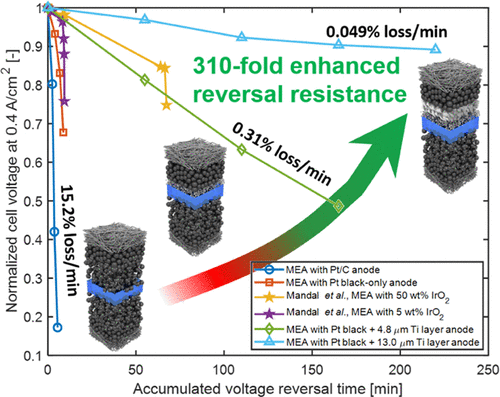当前位置:
X-MOL 学术
›
ACS Appl. Energy Mater.
›
论文详情
Our official English website, www.x-mol.net, welcomes your feedback! (Note: you will need to create a separate account there.)
Reversal Tolerant Anodes Using Protective Layers for Highly Robust Automotive Fuel Cells
ACS Applied Energy Materials ( IF 6.4 ) Pub Date : 2021-01-12 , DOI: 10.1021/acsaem.0c02011 Leiming Hu 1 , Bo Ki Hong 2 , Jong-Gil Oh 2 , Shawn Litster 1
ACS Applied Energy Materials ( IF 6.4 ) Pub Date : 2021-01-12 , DOI: 10.1021/acsaem.0c02011 Leiming Hu 1 , Bo Ki Hong 2 , Jong-Gil Oh 2 , Shawn Litster 1
Affiliation

|
Fuel cell electric vehicles (FCEVs) powered by polymer electrolyte membrane fuel cells (PEMFCs) need an improvement in their durability and robustness to achieve broader commercialization. Cell reversal induced by hydrogen starvation could significantly reduce the performance and durability of the PEMFC system in a short time. Here, we present the cell performance degradation and cell failure mechanisms during hydrogen starvation through examining membrane electrode assemblies (MEAs) with several different anode structures. For an MEA with conventional anode composed of carbon-supported platinum catalyst (Pt/C), the degradation caused by cell reversal primarily comes from carbon support corrosion. It is worth noting that an MEA with Pt black-only anode without any carbon also fails during hydrogen starvation. It is postulated that cell failure and performance degradation of the MEA with Pt black-only anode are caused by the corrosion of carbon materials present in the anode microporous layer (MPL) in gas diffusion layers. Based on these findings, we proposed a reversal tolerant anode (RTA) composed of both Pt black as a catalyst layer and thin titanium (Ti) as a protective layer. The conventional MEA with Pt/C anode exhibits the highest cell voltage degradation rate of 15.2% loss/min and the lowest reversal tolerance, whereas this new RTA MEA with Pt black and 13.0 μm thick Ti layer anode gives the lowest cell voltage degradation rate of 0.049% loss/min and the highest reversal tolerance, which is an approximately 310-fold increase compared with the conventional MEA with Pt/C anode. These findings will greatly contribute to designing a new concept of RTAs and enhancing the cell voltage reversal tolerance of PEMFCs dramatically under severe operating conditions of hydrogen starvation and thus improving the competitiveness of FCEVs.
中文翻译:

使用保护层的耐逆转阳极,用于高度坚固的汽车燃料电池
由聚合物电解质膜燃料电池(PEMFC)驱动的燃料电池电动汽车(FCEV)需要提高其耐用性和耐用性,以实现更广泛的商业化。氢饥饿引起的细胞逆转会在短时间内显着降低PEMFC系统的性能和耐久性。在这里,我们通过检查具有几种不同阳极结构的膜电极组件(MEA),展示了氢饥饿期间的电池性能下降和电池故障机理。对于具有由碳负载铂催化剂(Pt / C)组成的常规阳极的MEA,由电池反转引起的降解主要来自碳载体腐蚀。值得注意的是,带有Pt黑色纯阳极而没有任何碳的MEA在氢缺乏期间也会失效。据推测,仅含Pt黑色阳极的MEA的电池故障和性能下降是由气体扩散层中阳极微孔层(MPL)中存在的碳材料腐蚀引起的。基于这些发现,我们提出了由铂黑作为催化剂层和薄钛(Ti)作为保护层组成的耐逆阳极(RTA)。具有Pt / C阳极的常规MEA的电池电压降解率最高,为15.2%/ min,反向耐受性最低,而具有Pt黑色和厚度为13.0μm的Ti层阳极的新型RTA MEA的电池电压降解率最低。 0.049%的损耗/分钟和最高的反向容差,与带有Pt / C阳极的常规MEA相比,大约增加了310倍。
更新日期:2021-01-25
中文翻译:

使用保护层的耐逆转阳极,用于高度坚固的汽车燃料电池
由聚合物电解质膜燃料电池(PEMFC)驱动的燃料电池电动汽车(FCEV)需要提高其耐用性和耐用性,以实现更广泛的商业化。氢饥饿引起的细胞逆转会在短时间内显着降低PEMFC系统的性能和耐久性。在这里,我们通过检查具有几种不同阳极结构的膜电极组件(MEA),展示了氢饥饿期间的电池性能下降和电池故障机理。对于具有由碳负载铂催化剂(Pt / C)组成的常规阳极的MEA,由电池反转引起的降解主要来自碳载体腐蚀。值得注意的是,带有Pt黑色纯阳极而没有任何碳的MEA在氢缺乏期间也会失效。据推测,仅含Pt黑色阳极的MEA的电池故障和性能下降是由气体扩散层中阳极微孔层(MPL)中存在的碳材料腐蚀引起的。基于这些发现,我们提出了由铂黑作为催化剂层和薄钛(Ti)作为保护层组成的耐逆阳极(RTA)。具有Pt / C阳极的常规MEA的电池电压降解率最高,为15.2%/ min,反向耐受性最低,而具有Pt黑色和厚度为13.0μm的Ti层阳极的新型RTA MEA的电池电压降解率最低。 0.049%的损耗/分钟和最高的反向容差,与带有Pt / C阳极的常规MEA相比,大约增加了310倍。



























 京公网安备 11010802027423号
京公网安备 11010802027423号